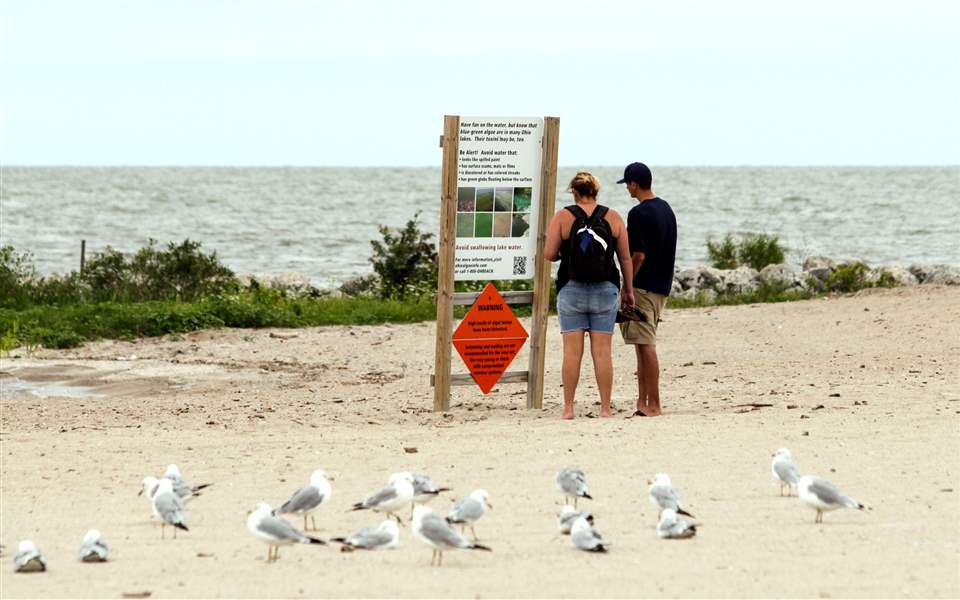
Lucas County seeks to join Lake Erie algae lawsuit
8/20/2018
Jamie Shiple, left, and her son, Clayton Landers, both of Goodyear, Ariz., in front of one of the algal toxins warning sign on the Lake Erie beach at Maumee Bay State Park in Jerusalem Township, Ohio on August 8, 2015.
The Blade/Jetta Fraser
Buy This Image
Lucas County wants to become one of the plaintiffs in a landmark case filed against the U.S. Environmental Protection Agency over the future cleanup strategy for western Lake Erie.
In a 23-page motion filed Monday afternoon in U.S. District Court, the county’s board of commissioners asked Senior Judge James G. Carr for authorization to become what’s known as a “party-plaintiff.” The status would give the county equal footing in the case as the two plaintiffs, which brought the lawsuit against the federal agency last year, the Environmental Law & Policy Center and Advocates for a Clean Lake Erie.
RELATED: Judge slams EPA over Lake Erie impairment controversy | Federal EPA reverses course on ‘voluntary’ algae reductions
The cities of Toledo and Oregon and two other groups, the Lake Erie Foundation and Guardians of Grand Lake St. Marys, have had requests approved by Judge Carr to assist the plaintiffs in other ways as friends of the court. Their respective amiscus motions were filed starting Aug. 10.
The flurry of motions has come in anticipation of Tuesday afternoon’s status update before Judge Carr, the first time in weeks both sides will meet in open court.
Fritz Byers, of Toledo, the attorney representing Lucas County commissioners in their request, stated in his motion the county wants to become the third plaintiff because the board’s interests “will be substantially affected by the outcome of the present action and that these interests can be adequately protected only by the board’s participation in the action.”
Like the two original plaintiffs, his complaint accuses the U.S. EPA and the Ohio EPA of foot-dragging and delays that are in violation of the federal Clean Water Act.
“The result of this government inaction has been catastrophic,” Mr. Byers’ complaint states. “While the regulatory agencies dallied, doing nothing of consequence, the water quality of western Lake Erie has declined alarmingly.”
The complaint further added this: “Despite actual knowledge of indisputable empirical information about the harmful effects of algal blooms in western Lake Erie, neither the Ohio EPA nor the U.S. EPA took even the minimal regulatory actions that under applicable federal laws are mandatory.”
Judge Carr himself accused the two regulatory agencies of showing a “whiff of bad faith” by their delays earlier this year.
The two regulatory agencies, as well as the U.S. Department of Justice — which is representing the U.S. EPA — has denied such accusations, with the Kasich administration pointing to large investments in better farming incentives and water treatment plants.
Madeline Fleisher, a Columbus-based ELPC lawyer serving as the lead plaintiff attorney, welcomed Lucas County’s request to become a co-plaintiff.
“It’s another government entity adding to the chorus,” Ms. Fleisher said. “They're tired of the Ohio EPA and the U.S. EPA not doing anything ... Both forms of involvement just highlight the fact that Ohio citizens are being hurt by toxic algae in their water.”
The case now centers on whether the U.S. EPA should require the state of Ohio to impose the most aggressive and comprehensive type of strategy aimed at reducing algae-forming phosphorus from Lake Erie and its tributaries, known as a total maximum daily load, or TMDL, program.
Plaintiffs argue that type of program is required under the federal Clean Water Act. The U.S. Department of Justice, on behalf of the U.S. EPA disagrees.
Lucas County Commissioner Tina Skeldon Wozniak said commissioners are “making it very clear we want a seat at the table.”
She said the board wants the county to be directly involved in setting up a total maximum daily load for the western Lake Erie watershed. Under a TMDL, western Lake Erie would have a cap on how much phosphorus could be reasonably allowed into it without forming large algal blooms. There would be site-specific mandates for those handling phosphorus, especially large farming operations. Phosphorus is one of the most common nutrients. It is found in animal manure, raw human waste treated at sewage plants, commercial fertilizers, and other products.
“We're doing what we believe we have to do and demand action to protect this resource,” Ms. Skeldon Wozniak said. “We believe the ELPC is on the right track to get the TMDL status.”
In a joint statement, commissioners said they could have the county “participate fully in the case by introducing evidence, advancing legal arguments, and pursuing remedies to safeguard our most precious natural resource.”
“We must hold both agencies accountable to take specific, measurable steps to ensure clean, safe drinking water, and to restore the health and economic vitality of Lake Erie,” the statement reads. “The Board of Lucas County Commissioners is asking the federal court to require the federal and Ohio EPA to do their jobs.”
In another motion filed Monday, the ELPC said it is seeking attorney fees and costs of $288,561.46 to date.
Contact Tom Henry at: thenry@theblade.com, 419-724-6079, or on Twitter @ecowriterohio.